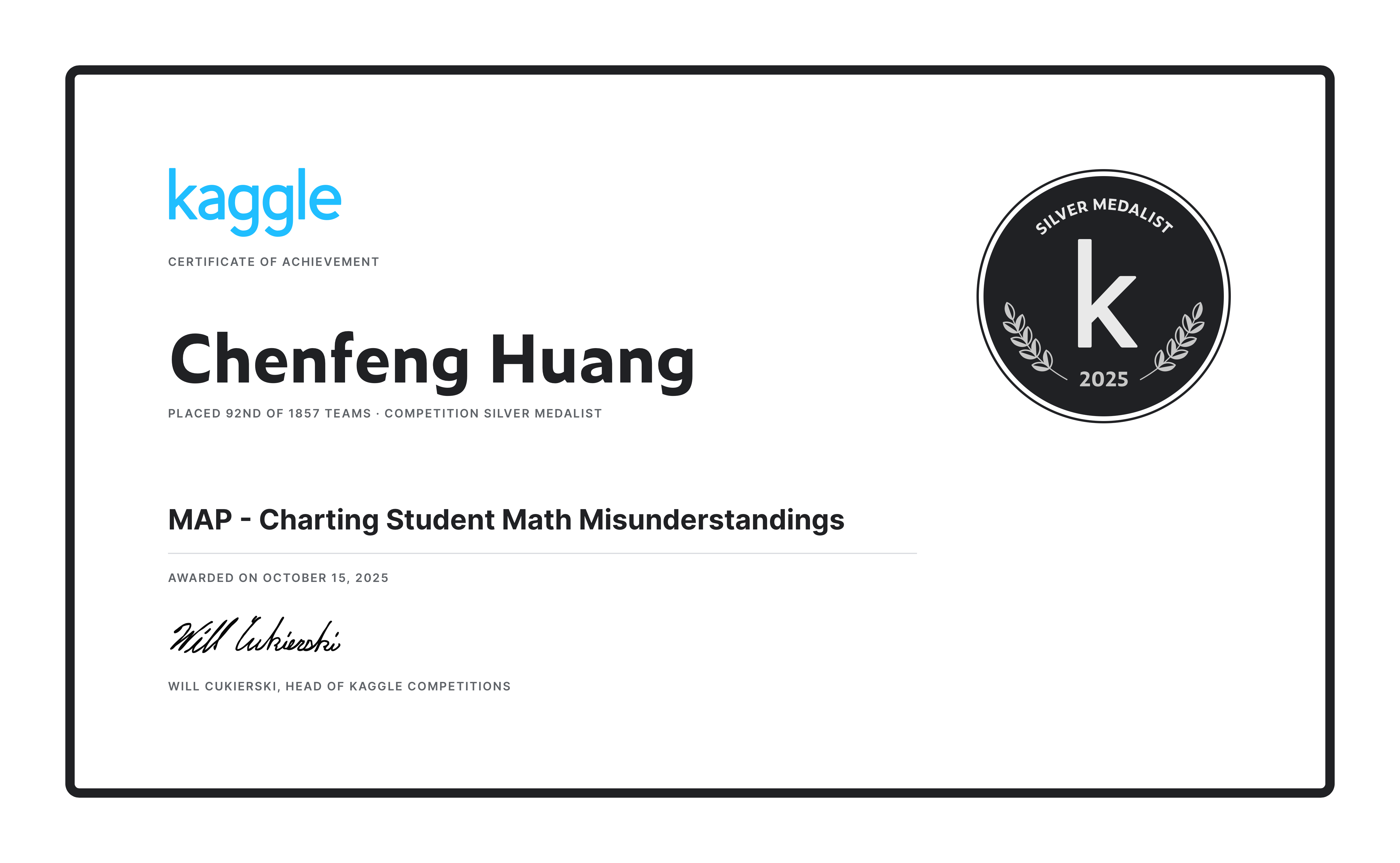Kaggle Competition Silver Medal: MAP - Charting Student Math Misunderstandings

I received my Silver Medal achievement in the MAP - Charting Student Math Misunderstandings Kaggle competition, marking my first participation in LLM language model competition.
The challenge required identifying whether a student’s free-text explanation exhibited a mathematical misconception and, if so, classifying the specific misconception type. Predictions were evaluated using MAP@3, emphasizing high-precision top-rank retrieval.
The task required building NLP models capable of generalizing across diverse math problems, handling long-tail misconception categories, and integrating question context, student choices, and open-ended explanations.
Our solution pipeline consisted of four key stages:
Stage 1 — Data Preprocessing
Unified Joint Label Space
All training targets were mapped into a single multi-class space:
Category:Misconception (with NA for non-misconception cases).
This avoided cascading errors inherent to multi-stage models.
Question-Level Correctness Prior
From training data, the most frequently correct MC answer was computed for each QuestionId.
This enabled:
- A strong structural feature:
Is Correct Answer: Yes/No - Later family prefix filtering (
True_vsFalse_)
Input Construction
Each model input concatenated:
- Question text
- Selected answer
- Correctness hint
- Student explanation
Tokenized with max_length=256 using dynamic truncation.
Stage 2 — Model Architecture and Training
LLM Backbone (Qwen3 4B / 8B / 14B)
Since ttudent explanations contain free-form reasoning, linguistic variation, and mathematical logic, a single unified classifier captures all semantics and avoids misalignment across multi-step pipelines. Models were finetuned using HuggingFace AutoModelForSequenceClassification, producing a single-head classifier over the full joint label set.
Parameter-Efficient LoRA Training
All experiments used LoRA applied to Q/V/O/gate/up/down projections.
Key training details:
- Precision: 4-bit (nf4) or BF16
- LR schedule: cosine with warmup
- Gradient checkpointing + dynamic padding
- 2–3 epochs, batch size 8–16
- LoRA rank scaled by model size (e.g., r=512 for 4B → r=16 for 14B)
Stage 3 — Inference and Postprocessing
Top-25 Candidate Preservation
Each model exported a Top-25 probability table, allowing richer uncertainty modeling in the ensemble stage.
Family Prefix Filtering (Key Innovation)
Using the correctness prior:
- If a row’s prefix should be
True_, filter out allFalse_* - If it should be
False_, filter out allTrue_*
This sharply constrained the error space and reflected domain structure.
Cross-Model Consistency Weighted Ensemble
Outputs from 4B, 8B, and 14B models were fused using:
- Weighted total probability (0.34)
- Cross-model consistency ratio (0.33)
- Max confidence across models (0.33)
This balanced global support, agreement, and peak reliability.
Completion Heuristics
If fewer than 3 predictions remained:
- Add
Neither:NA - For
True_cases, optionally addCorrect:NA
Ensuring fully valid MAP@3 submissions.
Stage 4 — Evaluation and Results
Leaderboard Scores
| Model | Precision | Method | Private LB |
|---|---|---|---|
| Qwen3-14B | 4-bit + LoRA | single model | 0.945 |
| Qwen3-8B | 4-bit + LoRA | single model | 0.944 |
| Qwen3-4B | FP16 + LoRA | single model | 0.944 |
| Ensemble (4B + 8B + 14B) | + family filtering | fused | 0.946 |
The ensemble improved upon the best individual model by +0.001, validating the benefit of structural priors and cross-model agreement.
Code Reference
Full implementation of training, inference, LoRA configuration, quantization setup, and ensemble logic is detailed in Github